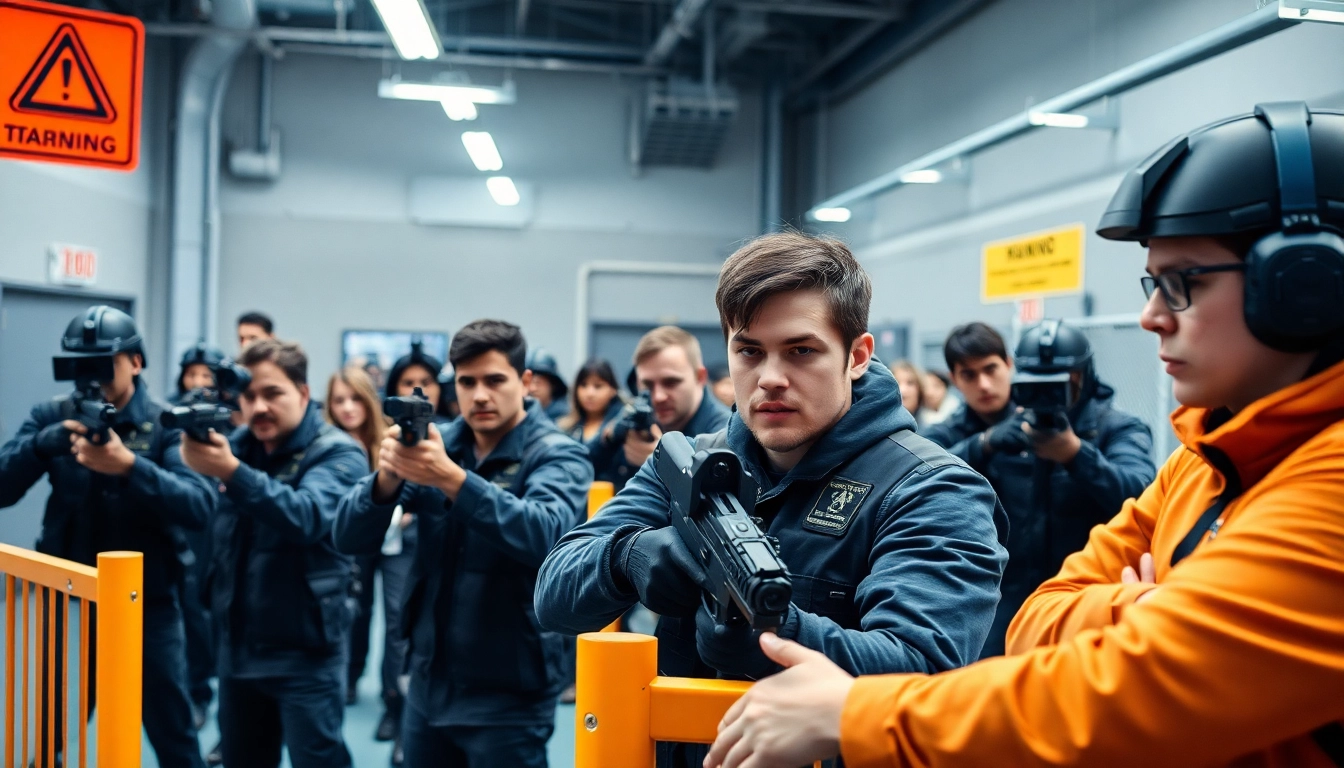Understanding Active Shooter Training
What is Active Shooter Training?
Active shooter training refers to a specialized educational program designed to prepare individuals and organizations for incidents involving an active shooter. These programs offer essential strategies on how to respond swiftly and effectively during a crisis, fostering a mindset of readiness among participants. The training typically encompasses various components such as identifying threats, creating emergency action plans, and practicing tactical responses that can save lives. With increasing concerns about safety in various environments—from schools to workplaces—the significance of active shooter training has become paramount in today’s society.
Importance of Active Shooter Training
The importance of active shooter training cannot be overstated. Statistics reveal a troubling rise in mass shooting incidents globally, underscoring the necessity for proactive measures. Training empowers individuals to react effectively under pressure, potentially saving lives. Furthermore, it helps create a culture of safety and awareness in institutions, ensuring that everyone knows the appropriate response procedures. Organizations that prioritize active shooter training not only protect their personnel but also enhance overall organizational resilience and community trust.
Key Components of Effective Training Programs
To be effective, active shooter training programs must incorporate several key components:
- Threat Awareness: Educating participants on how to recognize warning signs and environmental cues that might indicate a potential threat.
- Emergency Response Protocols: Developing clear protocols to follow during an active shooter event, including evacuation routes and communication plans.
- Scenario-Based Exercises: Utilizing realistic scenarios that allow participants to practice their responses in a controlled environment, thereby reinforcing learning through practical experience.
- Psychological Preparedness: Addressing the mental and emotional aspects of encountering an active shooter event, including managing stress, panic, and decision-making under duress.
Best Practices for Conducting Active Shooter Training
Establishing Clear Objectives and Learning Outcomes
Before conducting active shooter training, it is essential to establish clear objectives and desired learning outcomes. This involves identifying the specific knowledge and skills participants should possess by the end of the training. Objectives should be tailored to the audience, considering various factors such as age, occupation, and community context. Clear goals not only guide the training process but also facilitate measurement of effectiveness through post-training evaluations, ensuring that participants gain the most relevant skills and knowledge applicable to their scenarios.
Creating Realistic Training Scenarios
One of the cornerstones of effective active shooter training is the inclusion of realistic training scenarios. These scenarios should mimic potential real-life situations as closely as possible. This might involve role-playing exercises, simulations, or drills that provide participants with practical, hands-on experience. Engaging participants in such scenarios enhances retention of information and improves their overall preparedness to act swiftly and decisively in a crisis. Moreover, incorporating feedback from participants in scenario development can yield insights that enhance the relevance and impact of the training.
Incorporating Feedback and Evaluation
Continuous improvement is vital for the success of active shooter training programs. Incorporating feedback mechanisms—such as post-training surveys, group discussions, and direct assessments—enables instructors to gauge participants’ understanding and comfort levels. This feedback also provides critical insights for refining future training sessions. Evaluation should focus not only on participants’ knowledge acquisition but also on their practical application of the skills learned during scenarios. Ultimately, this iterative process fosters a culture of preparedness and resilience.
Common Challenges in Active Shooter Training
Addressing Psychological Barriers
One of the most significant challenges in active shooter training is addressing psychological barriers faced by participants. Many individuals may feel apprehensive about the subject matter, fearing that discussions could evoke anxiety or discomfort. It is essential to create a safe and supportive environment during the training process. Instructors should communicate the purpose of the training and normalize discussions about fear, anxiety, and the psychological impacts of active shooter situations. Incorporative techniques like group discussions and supportive resources can help alleviate fears, making participants more receptive to training.
Ensuring Engagement and Participation
Another common challenge is ensuring that participants remain engaged and actively participate throughout the training. A passive learning environment can hinder the effectiveness of training, as participants may not absorb the material or develop necessary skills. To counteract this, trainers can employ a variety of interactive learning methods, such as hands-on practice, group decision-making activities, and Q&A sessions. By actively involving participants in the learning process, they will likely feel more invested and accountable, thereby improving retention and application of the skills taught.
Managing Logistics and Safety Concerns
Logistics and safety considerations are also crucial elements that can affect the conduct of active shooter training. Planning for the physical space, scheduling, participant availability, and the coordination of instructors all play roles in successful implementation. Additionally, when conducting drills or simulations, safety measures must be prioritized to prevent any unintended consequences or injuries. Organizations should have comprehensive plans in place that include risk assessments, safety protocols, and designated training facilitators to ensure that all aspects of training are executed seamlessly and safely.
Advanced Techniques in Active Shooter Training
Leveraging Technology and Simulations
As technology advances, so too must training methodologies. Integrating technology into active shooter training can enhance the learning experience and provide more immersive experiences. Tools such as virtual reality (VR) and augmented reality (AR) can create lifelike simulations where participants can practice their responses to various scenarios in a controlled, risk-free environment. These advanced techniques allow individuals to gain practical experience without the emotional weight of a real crisis while still acknowledging the serious nature of such training.
Integrating Teamwork and Communication Skills
Active shooter situations rarely occur in isolation; they often involve multiple individuals and require effective teamwork and communication. Training programs should emphasize collaboration among participants, including the development of communication protocols and trust-building exercises. By practicing effective verbal and non-verbal communication strategies, participants can better coordinate during emergencies, leading to improved outcomes. Incorporating team-based exercises within the training fosters a sense of community and shared responsibility for safety.
Ongoing Training and Refresher Courses
Preparedness is not a one-time achievement; it is a continuous journey. For active shooter training programs to remain effective, organizations should invest in ongoing training and refresher courses. Regular updates and reviews of materials keep participants informed about evolving threats and best practices. Refreshers help reinforce skills learned during initial training, minimizing the potential for skill degradation over time. Developing a schedule for ongoing training can further enhance organizational readiness, ensuring that individuals feel equipped to act decisively in critical situations.
Measuring the Effectiveness of Active Shooter Training
Performance Metrics and Evaluation Methods
Measuring the effectiveness of active shooter training is crucial for validating its impact on participants and ensuring continuous improvement. Performance metrics can be established through combinations of qualitative and quantitative measures. For instance, instructors can use post-training assessments to evaluate knowledge retention and practical skills. Observation during drills can provide insight into participants’ execution of learned responses. Likewise, longitudinal studies following trainees through incidents can yield valuable feedback on the real-world applications of their training.
Gathering Participant Feedback
Participant feedback is an invaluable resource for assessing the efficacy of training programs. Surveys, interviews, and focus groups can gather qualitative insights on participants’ experiences, perceptions of the training, and areas identified for improvement. Such feedback should be actively solicited and regularly incorporated into training revision cycles. Encouraging a culture of open dialogue and reflection allows organizations to align training with the evolving needs and expectations of participants, maximizing the training’s relevance and effectiveness.
Adapting Training Programs Based on Data
Using collected data to adapt training programs ensures they remain relevant and impactful. Analyzing performance metrics and participant feedback can highlight both strengths and weaknesses in the current program. For example, if data indicates that participants struggle with specific scenarios during simulations, additional focus can be placed on those areas in future training sessions. Similarly, adapting content to reflect emerging trends and evolving threats can ensure that training remains proactive and robust in an ever-changing security landscape.







Leave a Reply